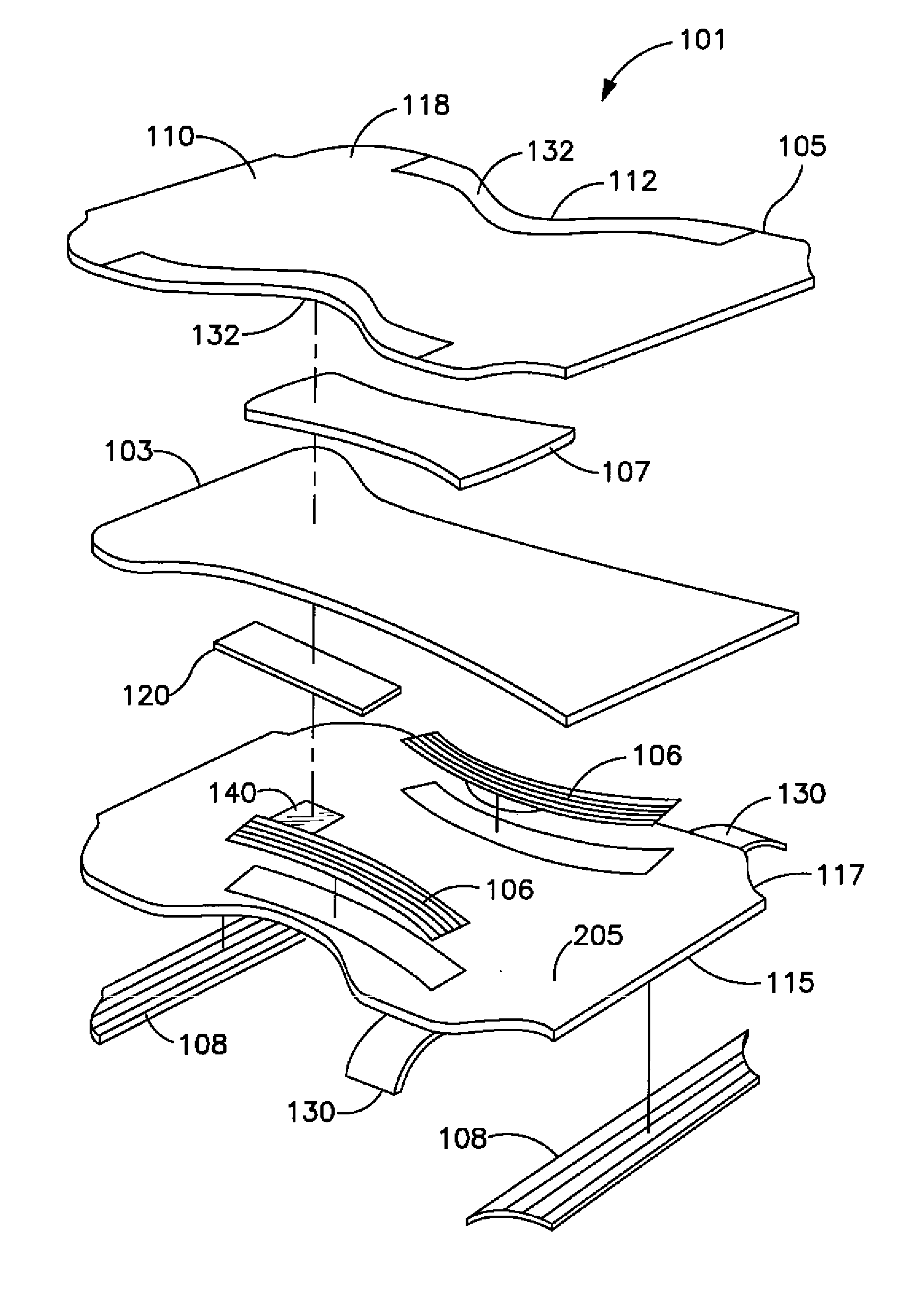Wetness sensor for use in an absorbent article
a technology for absorbent articles and wetness sensors, which is applied in the field of wetness sensors for use in absorbent articles, can solve the problems of wearers not being aware of the failure of urination control or the article should be changed, wearers may not realize they have urinated, and parents or caregivers may not recognize the need for changing the absorbent articl
- Summary
- Abstract
- Description
- Claims
- Application Information
AI Technical Summary
Benefits of technology
Problems solved by technology
Method used
Image
Examples
example 1
[0046]Violet Lactone II was dissolved in an ethanol solution at a concentration of 200 milligrams of the dye per milliliter of ethanol, 50 microliters of the dye solution was then mixed with 200 microliters of citric acid (100 milligrams per milliliter in ethanol). Thereafter, 20 microliters of the citric acid / dye solution was mixed with either 10 microliters of “940-1021” varnish from SunChemical (10 wt. % in ethanol) (“Sample A”); 10 microliters of “CASPER” varnish from SunChemical (10 wt. % in ethanol) (“Sample B”); or a mixture of 10 microliters of “940-1021” varnish (10 wt. % in ethanol) and 10 microliters of “CASPER” varnish (10 wt. % in ethanol) (“Sample C”). Samples A, B, and C were then separately applied to the outer cover of a PULL UP® diaper (Kimberly-Clark) and air dried. The color of the coated substrate was recorded. 10 microliters of water was then dropped on the coated substrate and observed. The color of the coated substrates was then recorded immediately after con...
example 2
[0048]1 milligram of Violet Lactone II and 10 milligrams of citric acid were dissolved in 50 microliters of ethanol. To this solution was added 100 microliters of cellulose acetate butyrate (CAB-553 from Eastman Kodak of Kingsport, Tenn.) in a solution of ethanol / n-propyl acetate (1:1 wt. ratio) at a concentration of 0.1 gram per milliliter. 30 microliters of the resulting dye solution was then applied to the outer cover of a PULL UP® diaper (Kimberly-Clark) and air dried. The color of the coated substrate was pink red. 10 microliters of water was then dropped on the coated substrate. The coated substrate became colorless immediately after contacting the water.
example 3
[0049]1 milligram of Violet I and 10 milligrams of citric acid were dissolved in 150 microliters of ethanol. To this solution was added 100 microliters of cellulose acetate butyrate (CAB-553 from Eastman Kodak of Kingsport, Tenn.) in a solution of ethanol / n-propyl acetate (1:1 wt. ratio) at a concentration of 0.1 gram per milliliter. 30 microliters of the resulting dye solution was then applied to the outer cover of a PULL UP® diaper (Kimberly-Clark) and air dried. The color of the coated substrate was blue. 10 microliters of water was then dropped on the coated substrate. The coated substrate became colorless immediately after contacting the water.
PUM
| Property | Measurement | Unit |
|---|---|---|
| temperature | aaaaa | aaaaa |
| weight ratio | aaaaa | aaaaa |
| weight ratio | aaaaa | aaaaa |
Abstract
Description
Claims
Application Information
 Login to View More
Login to View More - R&D
- Intellectual Property
- Life Sciences
- Materials
- Tech Scout
- Unparalleled Data Quality
- Higher Quality Content
- 60% Fewer Hallucinations
Browse by: Latest US Patents, China's latest patents, Technical Efficacy Thesaurus, Application Domain, Technology Topic, Popular Technical Reports.
© 2025 PatSnap. All rights reserved.Legal|Privacy policy|Modern Slavery Act Transparency Statement|Sitemap|About US| Contact US: help@patsnap.com



